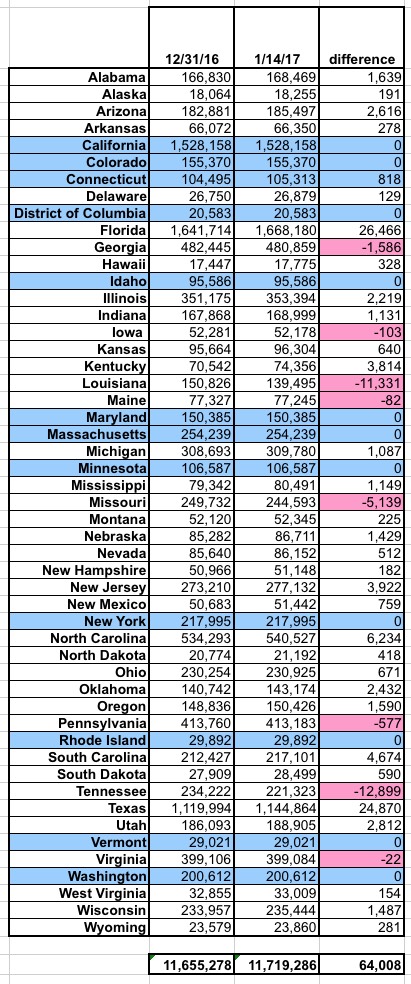One key reason HC.gov enrollments have flatlined: Better data management.
OK, given the impending End of the World As We Know it (and, on a smaller scale, the potential End of the Affordable Care Act), this is a pretty minor thing, but worth noting.
This afternoon I did a write-up about today's Week 10/11 HealthCare.Gov Snapshot Report, which showed nearly flat enrollment growth from 12/31 to 1/14...two solid weeks with barely 64,000 additional signups across 39 states. As I noted, this particular stretch of Open Enrollment was expected to be pretty quiet, but even so, the numbers were still far lower than I expected.
However, last year, the HC.gov team noted that they'd gotten much better about procesing/matching data with the carriers, the IRS, INS and so on. This means that unlike 2014 and 2015, where they had to wait until after the enrollment period ended to start "purging" bad enrollments, deadbeats/non-payments, cancellations and the like, they are now able to do so in a more real-time fashion...culling the enrollment records of void enrollees in the middle of the enrollment period itself.
The snapshot reports don't say anything about this, which means that if a state added, say, 20,000 new enrollees but subtracted 5,000 cancelled/purged enrollees, I'd have no way of knowing, since all I would see is a net increase of 15,000.
However, in cases where the increases are fairly small to begin with, there's some states where the number of enrollees purged outnumbers the additions, leading to a net decrease. Such is the case today. Compare HC.gov's Week 9 total (as of New Year's Eve) with the Week 11 numbers (as of January 14th) released today:

Yup. As you can see, net enrollments in eight states is lower than it was 2 weeks ago...because however many new people signed up, even more were dropped (either voluntarily or due to non-payment/legal issues). The total net reduction is nearly 32,000 people. However, it's actually a lot more than that; you just can't see it in the other states because there's no way of knowing how much their numbers were reduced by.
For practical purposes, this doesn't really change anything. It'll make the March 31st Effectuation Report drop less dramatically than it otherwise would (ie, instead of, say, a 2 million enrollee drop from 1/31 to 3/31, it might only be 1.3 million or whatever...because the 1/31 number will be lower to begin with), but otherwise it doesn't mean much. And, of course, if the GOP does follow through with repealing the ACA, it's all kind of a moot point regardless. still, it does help explain why the net increase is so minor, so I figured I should at least mention it.



